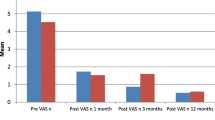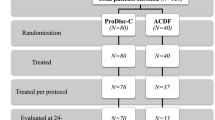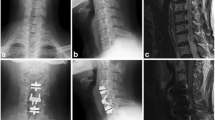Abstract
Background
The current use of external cervical orthoses (ECO) after cervical discectomy is still based on a common practice than a solid scientific literature. The aim of this study is to evaluate the impact of ECO on radiological and functional outcomes in patients undergoing anterior cervical discectomy and fusion (ACDF).
Methods
We compared two cohorts of consecutive patients who underwent ACDF with and without ECO after surgery. Thirty-six patients operated from January 2015 to June 2016 received an ECO whereas 36 patients, operated from July 2016 to December 2017, did not. Each patient underwent radiological and functional evaluation using plain x-ray at 1, 6, and 12 months after surgery and Neck Disability Index (NDI) at 2 weeks and 3, 6, and 12 months after surgery, respectively.
Results
In the ECO group, 5 patients (13.9%) presented an incomplete fusion and 31 patients (86.1%) presented a complete fusion (CI 0.705–0.953). In the non-ECO group, 8 patients (22.2%) presented an incomplete fusion and 28 patients (77.8% [CI 0.608–0.899]) had a complete fusion, with no statistically significant differences between two groups. No statistically significant differences were also observed regarding the NDI neither at 2 weeks nor at 3-, 6-, and 12-month follow-up. At multivariate analysis, patients who underwent two-level ACDF showed a five-fold increased risk of worse NDI at 3-, 6-, 12-month (p = 0.003, CI 1.770–14.584) follow-up.
Conclusions
We advise against the routine use of ECO after single- or two-level ACDF as we did not find out any significant statistical differences between the two groups.


Similar content being viewed by others
References
Abbott A, Halvorsen M, Dedering Å (2013) (2013) Is there a need for cervical collar usage post anterior cervical decompression and fusion using interbody cages? A randomized controlled pilot trial. Physiother Theory Pract 29(4):290–300. https://doi.org/10.3109/09593985.2012.731627
Bohlman HH, Emery SE, Goodfellow DB, Jones PK (1993) Anterior cervical discectomy and arthrodesis for cervical radiculopathy. Long-term follow-up of one hundred and twenty-two patients. J Bone Joint Surg Am 75(9):1298–1307
Camara R, Ajayi OO, Asgarzadie F (2016) Are external cervical orthoses necessary after anterior cervical discectomy and fusion: a review of the literature. Cureus. 2016:8(7). https://doi.org/10.7759/cureus.688
Carette S, Fehlings MG (2005) (2005) Clinical practice. Cervical radiculopathy. N Engl J Med 353(4):392–399. https://doi.org/10.1056/NEJMcp043887
Connolly PJ, Grob D (1998) Bracing of patients after fusion for degenerative problems of the lumbar spine--yes or no? Spine (Phila Pa 1976) 23(12):1426–1428. https://doi.org/10.1097/00007632-199806150-00024
Elliott RE, Tanweer O, Boah A, et al. (2013) Is external cervical orthotic bracing necessary after posterior atlantoaxial fusion with modern instrumentation: meta-analysis and review of literature. World Neurosurg. 79(2):369–374.e12. doi:https://doi.org/10.1016/j.wneu.2012.03.022
Jagannathan J, Shaffrey CI, Oskouian RJ et al (2008) Radiographic and clinical outcomes following single-level anterior cervical discectomy and allograft fusion without plate placement or cervical collar. J Neurosurg Spine 8(5):420–428. https://doi.org/10.3171/SPI/2008/8/5/420
Krock N (1997) Immobilizing the cervical spine using a collar. Complications Nurs Manag Axone 18(3):52–55
Lunsford TR, Davidson M, Lunsford BR. (1994) The effectiveness of four contemporary cervical orthoses in restricting cervical motion. JPO J Prosthetics Orthot 1994;6(4)
Miller CP, Bible JE, Jegede KA et al (2010) The effect of rigid cervical collar height on full, active, and functional range of motion during fifteen activities of daily living. Spine (Phila Pa 1976) 35(26):E1546–E1552. https://doi.org/10.1097/BRS.0b013e3181cf6f73
Naylor JR, Mulley GP (1991) Surgical collars: a survey of their prescription and use. Br J Rheumatol 30(4):282–284
Penolazzi L, Lambertini E, Bergamin LS, et al. (2018) MicroRNA-221 silencing attenuates the degenerated phenotype of intervertebral disc cells. Aging (Albany NY). 10(8):2001–2015. doi: https://doi.org/10.18632/aging.101525
Robinson RA (1959) Fusions of the cervical spine. J Bone Joint Surg Am 41-A(1):1–6
Webber-Jones JE, Thomas CA, Bordeaux RE Jr (2002) The management and prevention of rigid cervical collar complications. Orthop Nurs 21(4):19–25
Zigler JE, Rogers RW, Ohnmeiss DD (2016) comparison of 1-level versus 2-level anterior cervical discectomy and fusion: clinical and radiographic follow-up at 60 months. Spine (Phila Pa 1976) 41(6):463–469. https://doi.org/10.1097/BRS.000000000000126
Acknowledgments
The authors wish to thank the statisticians Giorgia Valpiani (ACQUARI, University Hospital of Ferrara) and Elisa Maietti (Department of Biomedical and Neuromotor Sciences, University of Bologna; Center of Clinical Epidemiology, Department of Medical Sciences, University of Ferrara) for their precious help with interpretation of statistical analyses.
Author information
Authors and Affiliations
Corresponding author
Ethics declarations
Conflict of interest
The authors declare that they have no conflict of interest.
Ethical approval
All procedures performed in studies involving human participants were in accordance with the ethical standards of the Ethical Committee of Ferrara University and with the 1964 Helsinki Declaration and its later amendments or comparable ethical standards. The study was approved by Ethical Committee of Ferrara University Hospital (Ethics CE-AVEC number 55/2019/Oss/AOUFe).
Informed consent
Informed consent was obtained from all individual participants included in the study.
Additional information
Publisher’s note
Springer Nature remains neutral with regard to jurisdictional claims in published maps and institutional affiliations.
This article is part of the Topical Collection on Spine degenerative
Rights and permissions
About this article
Cite this article
Scerrati, A., Visani, J., Norri, N. et al. Effect of external cervical orthoses on clinical and radiological outcome of patients undergoing anterior cervical discectomy and fusion. Acta Neurochir 161, 2195–2200 (2019). https://doi.org/10.1007/s00701-019-04046-5
Received:
Accepted:
Published:
Issue Date:
DOI: https://doi.org/10.1007/s00701-019-04046-5




